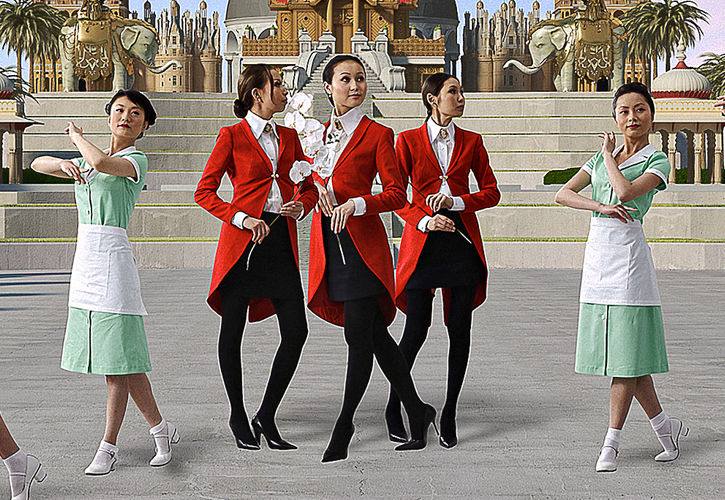This week’s Conversations at the Edge program features The Real-Fake curated by Claudia Hart, Rachel Clarke, and Pat Reynolds. This screening brings together 23 artists working with 3D simulation tools to produce a new aesthetic and ethic of the fake.

To accompany the program, we are excerpting media artist, curator, and theorist Patrick Lichty’s interview with Claudia Hart on Furtherfield, in which the two discuss what “real-fakeness” is, how it arrived as an art notion, and how it has informed the two versions of The Real-Fake exhibitions in 2011 and 2016.
Really Fake, or Faking Reality? Simulacra, Fake Art, and Breaking the Frame:
A Conversation between Patrick Lichty and Claudia Hart.
Patrick Lichty: What, in your mind does the show represent as an expression of contemporary culture?
Claudia Hart: The Real-Fake remake opened on November 19, slightly after the election. I was actually in the air when Trump won, landing in Bucharest, several hours later. The culture there is still overshadowed by the history of the totalitarian regime of Nicolae Ceaușescu. The contemporary art museum actually sits in a corner of his Palace of the People, which was built in the style of WWII Italo-fascist Neoclassicism. The whole experience was ominous and frightening in relation to the autocratic, punitive Trump. I began obsessively tracking “fake news”, both because of its relationship to the kind of propaganda used by the Trump/Bannon team to hijack the presidency, but also because of the hacking of the democratic party and collusion of the Republicans with the government of Vladimir Putin.
In both the 2011 and the 2016 versions of the Real-Fake exhibition, we tried to deconstruct, for simplicity’s sake, what I’m now calling “post-photography”, or what Steven Shaviro termed as the “Post-Cinematic.” This relates to digital simulations of the real made with current technologies of representation and post-mechanical reproduction. Post Photography can be defined by what it is NOT in relation to everything documentary and verité about photography. It suggests a radical paradigm shift with significant cultural ramifications. Post Photography does not purport to “slice” from life, but rather is a parallel construction of it, numerically modeled with the same techniques used by scientists, and also by the game and Hollywood special effects industries. The artists working with it all use specialized compositing and 3D animation software. But instead of capturing the real in an indexical fashion, Post Photography artists use measured calculations to simulate reality.
Our deconstruction of the post-photographic real-fake was made in relation to cultural myths about the truth, through viewing the work of 50 artists. They are all part of a larger community acutely aware of the implications of using a computer model of the real as opposed to traditional capture technology. The issues implied by this choice have obviously been made manifest at our own historical juncture, when the culture of science and climate-change deniers rule America. The manufacturing of fake truth in the form of misinformation and ubiquitous infotainment are now profoundly epic.
I’m currently reading Gabriella Coleman’s Hacker, Hoaxer Whistleblower, Spy: The Many Faces of Anonymous (Verso, 2014) a history of hacker culture related to both the esthetics of “Real-Fakeness” and also the actual milieu that it emerged from. I’m inspired at the moment by that book, and the brilliant essay “Tactical Virality” by Hannah Barton (Real Life, February 14, 2017) because they’ve helped me to articulate what I now feel is the relationship of The Real-Fake to our current cultural and political quagmire. What excited me about the Barton article is that she finds language to talk about the fake news, meaning in larger terms, the fake media strategy so successfully implemented by the Trump/Bannon team. Both of these men are fake-media production experts, and individually built lucrative empires with their expertise. Fake news is a product, and one can trace its lineage from the first alt-right radio flamers, through Fox, Breitbart and now, embodied in the personage of Steve Bannon, straight into the oval office. Fake news is a semiotic morph, a kind of hybrid of advertising and spectacular entertainment covered by a gloss surface of “news” or facts, that can be output in a range of forms from talking-head news commentators, to pseudo down-and-dirty cinema verité documentary. It is a knowing contemporary version of propaganda, and in fact, as reported by Joshua Green in Bloomberg Politics in 2015 even, in a chilling profile of Steve Bannon (https://www.bloomberg.com/politics/graphics/2015-steve-bannon/), Andrew Breitbart himself called Bannon out as “the Leni Riefenstahl of the Tea Party movement.”
So, with Bannon/Trump, we have entered into a paradoxical social-media semiotic in which that which most strongly resembles what Stephen Colbert dubbed as “truthiness” must be suspected as being the biggest lie.
PL: And to focus this back to art, perhaps what we might say is that instead of Picasso’s axiom of artists telling lies to reveal the truth, to make a fake “real” is to go through the machinations of media manipulation that Robert Reich talked about, like pulling the media in and driving conversation until it’s “almost real.” Maybe that’s the quality of “Real-Fakeness,” or even “Fake-Realness” (to do a structural inversion). And with “Simulationists” as we are, and postinternet artists, perhaps veracity and verisimilitude aren’t the point anymore. Maybe it’s just what’s in the boxes and “teh netz”.
CH: Exactly. All of these players are deploying the representational tactic of structural inversion, one of the techniques used to grab audience attention and leverage in the Internet media economy. Bannon’s professional canniness in rerouting the attention economy into fake news, was that flaming mis/information could be sold as a very lucrative attention-economy product. Likewise Trump made a fortune within this economy. Both are experts in the tactics required to make a thing go viral, in hacking the media/entertainment system for maximum clicks. Their approach obviously works. And you can see this in some of the work in the show.
Read the full interview here.